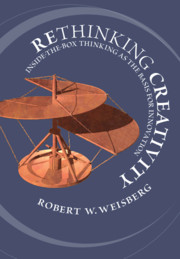Book contents
- Rethinking Creativity
- Rethinking Creativity
- Copyright page
- Dedication
- Contents
- Figures
- Tables
- Part I Introduction
- Part II Analytic Thinking in Creativity
- Part III The Question of Extraordinary Thought Processes in Creativity
- Part IV The Psychometrics of Creativity
- 10 Testing for Creativity
- 11 The Search for the “Creative Personality”
- 12 Two Confluence Theories of Creativity
- Part V The Neuroscience of Creativity
- References
- Index
10 - Testing for Creativity
Divergent Thinking, Executive Functioning, and Creative Thinking
from Part IV - The Psychometrics of Creativity
Published online by Cambridge University Press: 01 October 2020
- Rethinking Creativity
- Rethinking Creativity
- Copyright page
- Dedication
- Contents
- Figures
- Tables
- Part I Introduction
- Part II Analytic Thinking in Creativity
- Part III The Question of Extraordinary Thought Processes in Creativity
- Part IV The Psychometrics of Creativity
- 10 Testing for Creativity
- 11 The Search for the “Creative Personality”
- 12 Two Confluence Theories of Creativity
- Part V The Neuroscience of Creativity
- References
- Index
Summary
The idea that one can test people’s creative potential has been around since the turn of the twentieth century. Modern interest in testing for creativity began around 1950 and evolved out of the intelligence-testing or psychometric movement in the United States. The chapter begins by examining Guilford’s pioneering proposal concerning development of tests for creativity. Guilford proposed that the thought processes underlying creativity are different than those measured by IQ tests. He used the term divergent thinking to describe the thinking underlying creativity, and he developed a set of tests to measure it. This chapter reviews the tests that have been developed to measure the capacity to think creatively. One important question whether Guilford was correct in proposing that IQ and creativity involved different thinking skills. We shall review recent research addressing that issue, specifically research that, contrary to the “divergent thinking” perspective, has provided evidence for the role of two components of IQ, fluid intelligence and executive functioning, in creative thinking.
Keywords
- Type
- Chapter
- Information
- Rethinking CreativityInside-the-Box Thinking as the Basis for Innovation, pp. 319 - 352Publisher: Cambridge University PressPrint publication year: 2020



